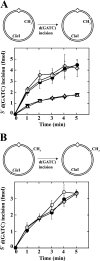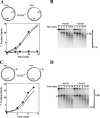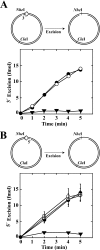Involvement of the beta clamp in methyl-directed mismatch repair in vitro
- PMID: 19783657
- PMCID: PMC2781695
- DOI: 10.1074/jbc.M109.054528
Involvement of the beta clamp in methyl-directed mismatch repair in vitro
Abstract
We have examined function of the bacterial beta replication clamp in the different steps of methyl-directed DNA mismatch repair. The mismatch-, MutS-, and MutL-dependent activation of MutH is unaffected by the presence or orientation of loaded beta clamp on either 3' or 5' heteroduplexes. Similarly, beta is not required for 3' or 5' mismatch-provoked excision when scored in the presence of gamma complex or in the presence of gamma complex and DNA polymerase III core components. However, mismatch repair does not occur in the absence of beta, an effect we attribute to a requirement for the clamp in the repair DNA synthesis step of the reaction. We have confirmed previous findings that beta clamp interacts specifically with MutS and MutL (López de Saro, F. J., Marinus, M. G., Modrich, P., and O'Donnell, M. (2006) J. Biol. Chem. 281, 14340-14349) and show that the mutator phenotype conferred by amino acid substitution within the MutS N-terminal beta-interaction motif is the probable result of instability coupled with reduced activity in multiple steps of the repair reaction. In addition, we have found that the DNA polymerase III alpha catalytic subunit interacts strongly and specifically with both MutS and MutL. Because interactions of polymerase III holoenzyme components with MutS and MutL appear to be of limited import during the initiation and excision steps of mismatch correction, we suggest that their significance might lie in the control of replication fork events in response to the sensing of DNA lesions by the repair system.
Figures








Similar articles
-
Hydrolytically deficient MutS E694A is defective in the MutL-dependent activation of MutH and in the mismatch-dependent assembly of the MutS.MutL.heteroduplex complex.J Biol Chem. 2003 Dec 5;278(49):49505-11. doi: 10.1074/jbc.M308738200. Epub 2003 Sep 23. J Biol Chem. 2003. PMID: 14506224
-
Interaction of Escherichia coli MutS and MutL at a DNA mismatch.J Biol Chem. 2001 Jul 27;276(30):28291-9. doi: 10.1074/jbc.M103148200. Epub 2001 May 22. J Biol Chem. 2001. PMID: 11371566
-
Methyl-directed mismatch repair is bidirectional.J Biol Chem. 1993 Jun 5;268(16):11823-9. J Biol Chem. 1993. PMID: 8389365
-
Structure and function of mismatch repair proteins.Mutat Res. 2000 Aug 30;460(3-4):245-56. doi: 10.1016/s0921-8777(00)00030-6. Mutat Res. 2000. PMID: 10946232 Review.
-
[Molecular mechanism of mismatch repair].Tanpakushitsu Kakusan Koso. 2001 Jun;46(8 Suppl):1124-9. Tanpakushitsu Kakusan Koso. 2001. PMID: 11436301 Review. Japanese. No abstract available.
Cited by
-
A 'Semi-Protected Oligonucleotide Recombination' Assay for DNA Mismatch Repair in vivo Suggests Different Modes of Repair for Lagging Strand Mismatches.Nucleic Acids Res. 2017 May 5;45(8):e63. doi: 10.1093/nar/gkw1339. Nucleic Acids Res. 2017. PMID: 28053122 Free PMC article.
-
On the mutational topology of the bacterial genome.G3 (Bethesda). 2013 Mar;3(3):399-407. doi: 10.1534/g3.112.005355. Epub 2013 Mar 1. G3 (Bethesda). 2013. PMID: 23450823 Free PMC article.
-
Spatial coupling between DNA replication and mismatch repair in Caulobacter crescentus.Nucleic Acids Res. 2021 Apr 6;49(6):3308-3321. doi: 10.1093/nar/gkab112. Nucleic Acids Res. 2021. PMID: 33677508 Free PMC article.
-
Mismatch repair causes the dynamic release of an essential DNA polymerase from the replication fork.Mol Microbiol. 2011 Nov;82(3):648-63. doi: 10.1111/j.1365-2958.2011.07841.x. Epub 2011 Sep 30. Mol Microbiol. 2011. PMID: 21958350 Free PMC article.
-
MutL traps MutS at a DNA mismatch.Proc Natl Acad Sci U S A. 2015 Sep 1;112(35):10914-9. doi: 10.1073/pnas.1505655112. Epub 2015 Aug 17. Proc Natl Acad Sci U S A. 2015. PMID: 26283381 Free PMC article.
References
Publication types
MeSH terms
Substances
Grants and funding
LinkOut - more resources
Full Text Sources
Molecular Biology Databases

